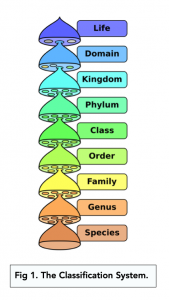Phylogeny and Classification (A-level Biology)
Phylogeny and Classification
Phylogeny
Taxonomy takes into account many things, including the physical appearance of organisms, the anatomy, the genetics and the physiology. More recently, phylogeny has been used.
Phylogeny is the study of the evolutionary relationships between organisms.
The Phylogenetic Classification System
The current phylogenetic classification system arranges species into 8 taxonomical groups based on their evolutionary origins and relationships. It uses a hierarchy in which smaller groups are placed within larger groups, Each group is called a taxon (plural taxa).
The 8 groups are:
Domain, Kingdom, Phylum, Class, Order, Family, Genus, Species
A simple pneumonic to remember this is: “Dear King Phillip Came Over For Good Soup”.

Here are some key points about the system:
- There is no overlap between groups. An organism can only be in one group at each level.
- Higher groups have many organisms. There are more organisms in the early groups, and less and less as you move down the classification system
- Organisms lower down are more closely related. Organisms in the same lower groups are more closely related. For example, organisms in the same species are more closely related than organisms in the same domain.
- The system is always updating. The classification system is continually evolving and changing as new types of analysis are discovered (e.g. gene sequencing).





Still got a question? Leave a comment
Leave a comment